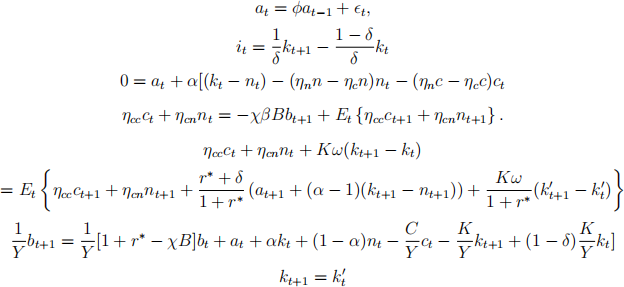ECON 8100: International Finance
Take Home Exam 1
1. Consider the International Business Cycle model with an exogenous technological shock discussed in the class.

Now we have 5 equations and 5 variables. Before you proceed, note that the system involves kt+2 as well as kt+1 and kt : it is a second order system. This is due to the adjustment cost term.
Assume that the variance of the innovation to the productivity shock is nil: ϵt = 0. We refer to such an environment as a deterministic economy. We need to define deterministic steady state as an equilibrium of the deterministic economy in which all endogenous variables are constant over time.

We deal with kt+2 by defining the variable k′t = kt+1. Observe that k′t is non-predetermined at time t. Consider the International Business Cycle model with an exogenous technological shock discussed in the class.

where we note that the last equation is an auxiliary equation so that we can include kt+2 in the equations. This is a system of 6 equations and 6 unknowns
You can also add the following equations for analysis.

where the steady-state level of trade balance is equal to

The baseline calibration of the mode’s parameters are
Table 1: Calibration of the small open economy RBC model

Using the model described in the class, analyze and discuss how economy responds to the trichology shock.
In your analysis, the following discussion must be included.
Impulse response analysis of main variables. Produce a figure with five plots depicting the impulse responses to a technological shock of k, c, n, i, ytb and ca.
Discussion regarding second moments of main variables. Produce a table displaying the unconditional standard deviation, serial correlations, and correlation with output of k, c, n, i, y, tb and ca.
Based on your analysis, explain the effects of a technological shock to the business cycle.